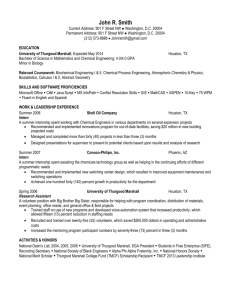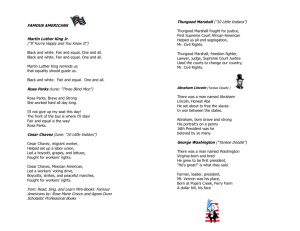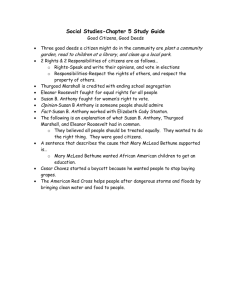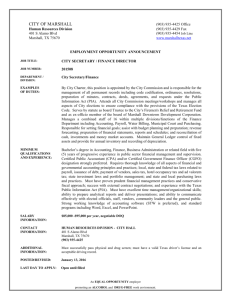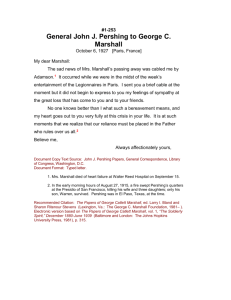The Diocese of Washington Resolution
advertisement
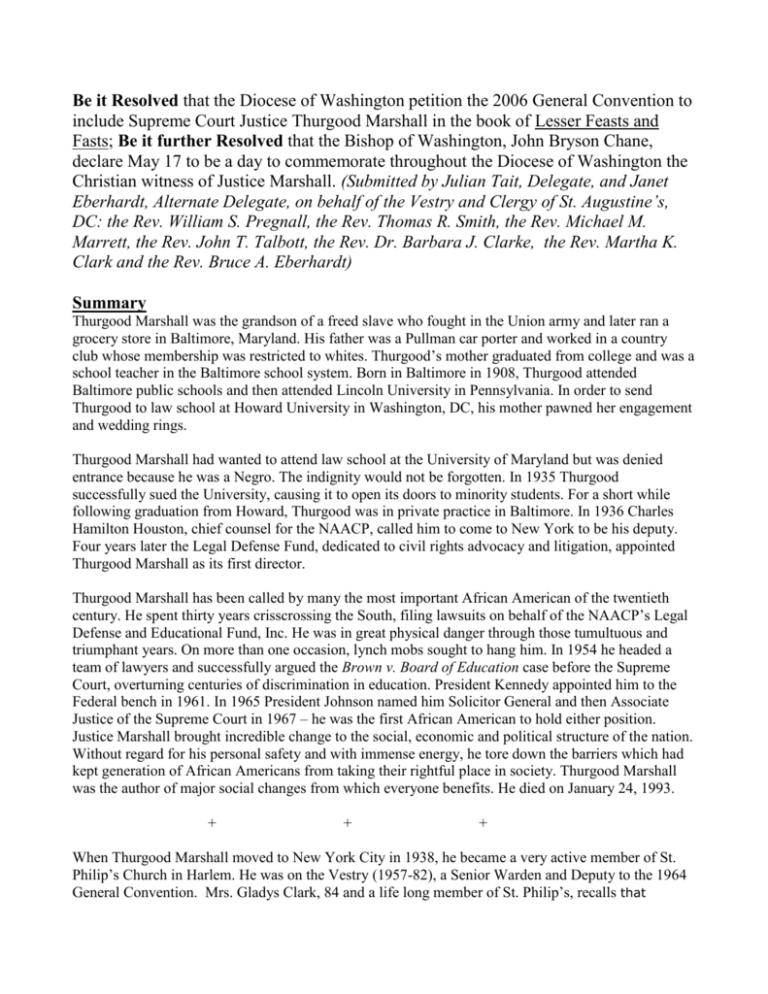
Be it Resolved that the Diocese of Washington petition the 2006 General Convention to include Supreme Court Justice Thurgood Marshall in the book of Lesser Feasts and Fasts; Be it further Resolved that the Bishop of Washington, John Bryson Chane, declare May 17 to be a day to commemorate throughout the Diocese of Washington the Christian witness of Justice Marshall. (Submitted by Julian Tait, Delegate, and Janet Eberhardt, Alternate Delegate, on behalf of the Vestry and Clergy of St. Augustine’s, DC: the Rev. William S. Pregnall, the Rev. Thomas R. Smith, the Rev. Michael M. Marrett, the Rev. John T. Talbott, the Rev. Dr. Barbara J. Clarke, the Rev. Martha K. Clark and the Rev. Bruce A. Eberhardt) Summary Thurgood Marshall was the grandson of a freed slave who fought in the Union army and later ran a grocery store in Baltimore, Maryland. His father was a Pullman car porter and worked in a country club whose membership was restricted to whites. Thurgood’s mother graduated from college and was a school teacher in the Baltimore school system. Born in Baltimore in 1908, Thurgood attended Baltimore public schools and then attended Lincoln University in Pennsylvania. In order to send Thurgood to law school at Howard University in Washington, DC, his mother pawned her engagement and wedding rings. Thurgood Marshall had wanted to attend law school at the University of Maryland but was denied entrance because he was a Negro. The indignity would not be forgotten. In 1935 Thurgood successfully sued the University, causing it to open its doors to minority students. For a short while following graduation from Howard, Thurgood was in private practice in Baltimore. In 1936 Charles Hamilton Houston, chief counsel for the NAACP, called him to come to New York to be his deputy. Four years later the Legal Defense Fund, dedicated to civil rights advocacy and litigation, appointed Thurgood Marshall as its first director. Thurgood Marshall has been called by many the most important African American of the twentieth century. He spent thirty years crisscrossing the South, filing lawsuits on behalf of the NAACP’s Legal Defense and Educational Fund, Inc. He was in great physical danger through those tumultuous and triumphant years. On more than one occasion, lynch mobs sought to hang him. In 1954 he headed a team of lawyers and successfully argued the Brown v. Board of Education case before the Supreme Court, overturning centuries of discrimination in education. President Kennedy appointed him to the Federal bench in 1961. In 1965 President Johnson named him Solicitor General and then Associate Justice of the Supreme Court in 1967 – he was the first African American to hold either position. Justice Marshall brought incredible change to the social, economic and political structure of the nation. Without regard for his personal safety and with immense energy, he tore down the barriers which had kept generation of African Americans from taking their rightful place in society. Thurgood Marshall was the author of major social changes from which everyone benefits. He died on January 24, 1993. + + + When Thurgood Marshall moved to New York City in 1938, he became a very active member of St. Philip’s Church in Harlem. He was on the Vestry (1957-82), a Senior Warden and Deputy to the 1964 General Convention. Mrs. Gladys Clark, 84 and a life long member of St. Philip’s, recalls that Thurgood was in NYC frequently on business after moving to DC and would return to St. Philips for parish dinners, etc. when he was in town. She also reported that Thurgood frequently gave talks to the young people of the parish urging them to be thankful for what they have but always to strive for more When he spoke that way, it could well have been in contrast to his wrenching travels through the Jim Crow south. When Thurgood became Solicitor General in 1965, the Marshall family moved to Washington, D.C., joining St. Augustine’s Church in Southwest. The Rev. Dr. M. Moran Weston, the St. Philip’s Rector at the time, kept Thurgood on the St. Philip’s Vestry after his relocation to Washington, DC. Dr. Weston had a few people like Thurgood (who were not expected to attend every meeting) on the roster so their names and presence assisted the church in its organizing and fund raising efforts. Their two sons were raised in St. Augustine’s Parish and Thurgood’s widow, ‘Cissy,’ is still a very active member there. In 1967, when he took the oath of office as Supreme Court Justice, his Bible was open to First Corinthians, 13th Chapter, taking his oath with his hand upon that text. He chose a text about love defined as a godly respect for the human dignity of others. Thurgood Marshall believed very strongly in the Constitutional principle of the separation of church and state. Consequently, once he became a Supreme Court Justice, he attended church very infrequently Concerned that he would develop partisan political views which affect his judgment as a Justice, ironically, he ceased voting in local and national elections. However, as his wife has often said, “it was his deep faith in God and the teachings of our church that gave him the strength and courage to seek equal justice for all, always doing the best he could with what he had.” In 1991 the General Convention, noting his impending retirement, passed a resolution, “offering thanks and profound gratitude to Justice Marshall for his long, courageous, and devoted service to the Constitution of the United States and the cause of equal rights and justice for all persons.” Before he died, Thurgood joined John Glenn as the only living Americans to have a clerestory window dedicated to them at Grace Cathedral in San Francisco. Testimony From Within The Church Thurgood Marshall and his family became members of St. Augustine’s in Southwest, D.C. when the family moved to Washington in 1965. In New York he had been a member of St. Philip’s, Harlem. Although his family attended church almost every Sunday, “the Judge,” as he preferred some to call him, did not. He did attend enough to be “respectable” about his membership, but he never equated church attendance with his being a Christian. Courts, not candles, were his milieu. Rather, his Christian faith was deep inside, and that presence of Holy Spirit within him was his plumb line. He could tell right from wrong instantaneously. His keen understanding of the place of his ministry, a ministry of the people of God, led him to the courts. There his contribution to the place of the AfroAmerican in our society is unequaled. Others got more press, e.g., Rosa Parks and Martin Luther King, but had it not been for Thurgood Marshall, segregation might still be the law of this land. The Spirit working through this man gave him an intuitive sense of justice in which he saw all of life as sacred and all persons equal before God. This same Spirit gave him a great sense of self transcendence which frequently expressed itself in humor. He could tell a “tale,” and his story telling, like Mark Twain’s, was not only funny but also had a huge sense of morality entwined. I knew him as a good man who loved to tease. He was a competitive man, and he loved to win. But, he was also a wise and godly man who knew his place and role in history and obeyed God’s call to follow justice wherever it 2 Prepared by Bruce Eberhardt, November 2005 led. (William S. Pregnall, Former Rector of St. Augustine’s, Retired) Thurgood Marshall exemplified in his life what it means to be a human being totally alive to his world and the lives within it. His Christian faith was deep inside his being and it was this faith which was the foundation and source of his energetic pursuit of justice. I personally know no other American of the 20th century so deserving to be honored by the Church. His life was a splendid witness to what the Holy Spirit can summon in one human life. (Thomas R. Smith, Former Rector of St. Augustine’s, Retired) The prophet Amos was Thurgood Marshall’s kind of man. He was bold, caustic and candid in the most difficult of times. And although the good Justice would be loathe to mingle religious symbols with political, Thurgood Marshall was indeed a prophet in his own right, fighting for the ancient vision of God for an equitable society. We call it justice, the right ordering of social relationships and opportunities. Justice Marshall stated it simply as “getting the same thing at the same time in the same place.” Justice Marshall was an incredible man, a superior lawyer who would have been renowned as a civil rights lawyer with the most distinguished record among Supreme Court lawyers to date, even if he had not become a Justice. Of course, as a Justice he had a passionate commitment to make real the constitutional intent for all people, especially the 11th thru the 15th Amendments. All of this was grounded not simply in moral conviction, but a sense of Christian duty which was a central factor in his moral vision. He did not believe in an exclusive God. His favorite scripture text was the love text, which he understood from the Latin "caritas", i.e. a call to Divine love, which is not about warm, familiar affection, but rather a love for what God loves -- justice and equity. The reading from First Corinthians 13 was chosen when he was sworn in as Justice. It again was most appropriate as part of his final message, as Readings were chosen for that great liturgy in the National Cathedral, telecasted internationally. Sadly, in some ways this marked the end of an era, where political and social passions of moral integrity and faithfulness were about constitutional inclusion. Now, in our own time, constitutional integrity is unhappily defined as constricting inclusion, defining its benefits to the interest of a narrow ideology. Lifting up his life and witness may help keep alive this "caritas" mandate of the Gospel, in religious life as well as public discourse. (The Reverend Nathan D. Baxter, Rector, St. James Church, Lancaster, PA) My time as rector of St. Philip's Church came long after Thurgood Marshall's departure. However, my remembrances include that during my time at St. Philip's there were a number of persons in that congregation who knew him when he was a member and thought of him as a strong and dedicated churchman. I would be pleased to petition this Diocese to designate a day to commemorate Justice Marshall when the time comes to do that. (The Right Reverend Chester Talton, Bishop Suffragan of Los Angeles) Thurgood Marshall is a saint already in the Bay Area as people hearken back to his memory often. (The Right Reverend William Swing, Bishop of California) 3 Prepared by Bruce Eberhardt, November 2005 Biographical Information Thurgood Marshall was born on July 2, 1908 in Baltimore, Maryland to William and Norma Marshall. He was the younger of two sons. His father worked at a variety of jobs as porter, butler and yacht club steward. His mother was an elementary school teacher in Baltimore. The great-grandson of a slave brought to the Eastern Shore of Maryland from Africa’s Congo region, Justice Marshall was named for his paternal grandfather who had chosen the name “Thoroughgood” when he enlisted in the Union Army during the Civil War. By the second grade he had convinced his mother to shorten it to Thurgood because he disliked having to spell it. He was educated in public schools in Baltimore, graduating from Douglass High School with academic honors, but with a record of less than exemplary behavior. The school’s principal disciplined the future Justice by banishing him to the furnace room with a copy of the U.S. Constitution where he was instructed to memorize one section for each infraction. In two years he had memorized the entire document. Mr. Marshall attended Lincoln University, a small, private black school in Oxford, Pennsylvania. He worked a number of campus jobs to help pay his tuition before graduating with honors in 1930. In his senior year he married Vivian Burey who died of cancer in 1955. After being denied admittance to the all-white University of Maryland Law School, he was admitted to the Howard University Law School. During his second year in law school, Mr. Marshall – led by his mentor, Dean Charles Hamilton Houston – learned that street protests could communicate injustice to the public. Mr. Marshall with the dean and about twenty other students protested lynching by staging a demonstration in the Pan-American Building in Washington DC. When they were arrested two patrol wagons could not hold all the students so Mr. Marshall and a classmate hailed a cab to follow the patrol wagons to the precinct. He graduated at the top of his class in 1933. He passed the bar and went into private practice in Baltimore, specializing in civil rights cases. Early in his practice he was counsel for the colored laundry in Baltimore City (the second largest Negro enterprise in the city) and counsel for the only colored building association in the city. Thurgood Marshall was only 26 years old when he became legal counsel for the Baltimore branch of the NAACP. One of his first civil rights cases was a successful effort to gain admission for a young black man to the University of Maryland Law School. In 1936 Donald G. Murray was admitted into the very institution that had denied Marshall’s admittance just six years before. In 1996 a statue of Thurgood Marshall with Donald Murray was dedicated in State House Square in Annapolis, Maryland. In 1936 he also became an assistant to Charles Hamilton Houston, the NAACP’s special counsel and the man who greatly influenced his life. When Mr. Houston retired two years later, Marshall succeeded him and became the national organization’s chief legal officer. In 1939 Mr. Marshall secured admission to practice before the Supreme Court. That same year, the NAACP Legal Defense Fund was established after the Treasury Department had refused to grant tax-exempt status to the 30 year old 4 Prepared by Bruce Eberhardt, November 2005 NAACP. The Fund’s purpose was to raise money and spearhead the organization’s legal fight against discrimination and other programs that were clearly eligible for tax deductible contributions. Mr. Marshall served as counsel and director of the Fund from 1940 to 1961 and was responsible for dozens of legal actions “to secure and protect full citizenship rights for Negroes,” especially voting privileges, justice in criminal proceedings, and “equalizing expenditures for public education throughout the United States.” Throughout this period of grueling travel and meetings, he maintained his acute sense of humor even in the face of dangerous threats from whites and distrust by Blacks. Black Texans could not vote in primaries, so a suit had been filed in 1927 and languished off the docket. Mr. Marshall acted as the attorney and brought the suit back in 1941, finally winning Smith v. Allwright in 1944. He was so successful as a litigator that in 1946 the NAACP made him the thirty-first recipient of the coveted Spingarn Medal, presented annually to a person of African-American descent with the highest achievement in an honorable field of human endeavor. When the medal was presented to him, the citation noted “the Texas Primary Case conceivably may have more far reaching influence than any other act in the ending of disenfranchisement based upon race or color in the country.” He was called a “legal engineer,” a man of singular skill. In a series of maneuvers, each carefully calculated to undermine the suffocating tradition of segregation and discrimination. Marshall peacefully procured expanded voting powers, transportation rights and housing entitlements. Thurgood Marshall’s long and successful career as a trial attorney culminated with the 1954 Supreme Court decision, Brown v. Board of Education It was his first case before the Supreme Court and the key victory in the legal battle to dismantle segregation in the United States. When he and the other Fund lawyers presented their arguments in Brown, they utilized cases relating to segregated schools in various parts of the country so that the “separate but equal” doctrine could be challenged in a variety of settings throughout the country. The Court heard the case twice before ruling unanimously on May 17, 1954 that separate schools were inherently unequal, thus paving the way for future decisions declaring unconstitutional all racial segregation. The Brown decision became the springboard for affirmative action programs and other civil rights remedies. (At the time of Justice Marshall’s death, Benjamin Hook, the NAACP’s Executive Director, said, “It is my belief that without Thurgood Marshall, we would still be riding in the back of the bus, going to separate schools and drinking ‘colored’ water.”) In 1961, President John F. Kennedy appointed Thurgood Marshall to the United States Court of Appeals for the Second Circuit. Four years later President Lyndon B. Johnson named him Solicitor General of the United States. As Solicitor General he argued before and won the Supreme Court approval of the 1965 Voting Rights Act. In 1967 President Johnson nominated him to the Supreme Court to succeed Justice Tom Clark. Neither position had ever been held by an African-American, During Justice Marshall’s years on the Supreme Court he worked to solidify the Brown decision and other celebrated civil rights cases. His legendary record of opinions and dissents demonstrated his unwavering commitment to protecting the constitutional rights of all Americans, including the poor, Native Americans, the elderly, women, the oppressed, and the accused. He consistently argued for the rights of laborers and criminals and for the freedom of speech for all Americans. He was adamantly opposed to capital punishment throughout his entire career. 5 Prepared by Bruce Eberhardt, November 2005 Justice Marshall announced his retirement on June 27, 1991, citing the duties of a Justice were incompatible with his advancing age and medical condition. Asked how he would like to be remembered, he said, “I did the best I could with what I had.” On January 24, 1993, Justice Thurgood Marshall died of heart failure at Bethesda Naval Medical Center. He lay in repose, on the same catafalque of the U.S. Congress which bore the body of President Lincoln, in the Great Hall in the Supreme Court building on January 27, 1993. Over 18,000 people filed past the bier. A memorial service was held for Justice Marshall at the Washington National Cathedral on January 28, 1993 with the Very Reverend Nathan Baxter, Cathedral Dean, as Homilist. He was buried in a private ceremony at Arlington National Cemetery the following day with the Reverend William S. Pregnall, his former Rector at St. Augustine’s Church, as Officiant. His grave site is located near those of several other Supreme Court Justices. Since his death, innumerable schools, libraries and various buildings have been named after him, including the Federal Judiciary Building in Washington, DC. In October 2005, BWI Airport outside of Baltimore was renamed the Baltimore-Washington International Thurgood Marshall Airport. Professor Paul Gerwitz at the Yale Law School offers perhaps the best analysis of Justice Marshall’s courageous life which drew strength from his belief in the logic and fairness in the Rule of Law: “He grew up in a ruthlessly discriminatory world, a world in which segregation of the races was pervasive and taken for granted, where lynching was common, where the black man’s inherent inferiority was proclaimed widely and wantonly. Upon that desperate world, Marshall imposed a heroic imagination. He had the capacity to imagine a radically different world, the imaginative capacity to believe that such a world was possible, the strength to sustain that image in the mind’s eye and the heart’s longing, and the courage and ability to make that imagined world real.” Justice Marshall married Cecilia Suyat Marshall on December 17, 1955. They have two sons, Thurgood Marshall, Jr., and John William Marshall; four grandchildren, Patrick, Thurgood William, Cecelia, and Melonie; and two great-grandchildren, Cameron and Briana. Suggested Propers for Thurgood Marshall Eternal and Ever-Gracious God, you blessed your servant Thurgood with special gifts of grace and courage to understand and speak the truth as it has been revealed to us by Jesus Christ. Grant that by his example we may also know you and seek to realize that we are all your children, brothers and sisters of Jesus Christ , whom you sent to teach us to love one another; who lives and reigns with you and the Holy Spirit, one God for ever and ever. Amen. Amos 5:10-15, 21-24 Psalm 34:15-22 I Corinthians 13:1-13 Matthew 23:1-11 6 Prepared by Bruce Eberhardt, November 2005
